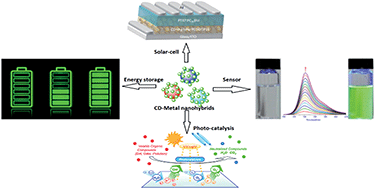Recent progress in carbon dot–metal based nanohybrids for photochemical and electrochemical applications
Abstract
Carbon dot (CD) is the youngest member of the carbon based nanomaterials family but it has emerged as the brightest in recent times, as now it is one of the most intensive research topics in the domain of materials science. The popularity is due to its excellent aqueous dispersibility, functionality, biocompatibility and ease of preparation from different carbon based resources. All such favorable attributes help CDs to find applications in the fields of optoelectronic, energy conversion, bio-imaging, drug delivery, sensors, catalysis, etc. Most recently, CD–metal based nanohybrids have been extensively employed for several photochemical and electrochemical applications due to their unique and interesting up-conversion photoluminescence and photo-induced electron/charge transfer properties. Therefore, the recent progress of CD–metal based nanohybrids in such applications needs to be compiled in the form of a review for highlighting their benefits to researchers in this field. In the present review, hence, fabrication methods, structural characterizations, properties and applications of CD–metal based nanohybrids are highlighted in a concise but systematic way to cover the desired information. Different photochemical and electrochemical applications like photocatalysis, solar cell or photovoltaic, energy storage, and photochemical and electrochemical sensors of the CD–metal based nanohybrids are focused in this article. This review thus tries to provide a decent and updated coverage on the topic.

- This article is part of the themed collection: Recent Review Articles

 Please wait while we load your content...
Please wait while we load your content...